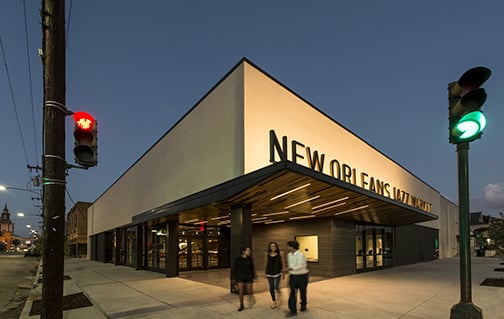Media Contact
Asa Posner
Senior Sustainability Manager
Sustainable Investment Group (SIG)
404.343.3835
asa@sigearth.com
The New Orleans Jazz Market Included in New Report that Reveals Venues Across the Globe are Embracing LEED Green Building
LEED in Motion: Venues report from U.S. Green Building Council features the impact LEED and green practices are having on venues’ triple bottom line
Washington, D.C. (Feb. 16, 2017) – Today, the U.S. Green Building Council released its LEED in Motion: Venues report, which highlights the efforts of convention centers, sports venues, performing arts centers, community centers and public assembly spaces to transform their environmental, social and economic footprint through LEED certification. The report showcases some of the most impressive green venues around the world including New Orleans Jazz Market.

Venues are large contributors to the U.S. economy. The U.S. Bureau of Labor Statistics reports that the number of conventions and events is expected to expand by 44 percent from 2010 to 2020 – far outpacing the average projected growth of other industries. Annually, the top 200 stadiums in the U.S. alone draw roughly 181 million visitors, and roughly 60 million people worldwide attend a consumer or industry trade show. Waste Management estimates that the NFL, MLB, NBA and NHL generate a combined 35,000 metric tons of CO2 each year from their fans’ waste. The convention and trade show industry, one of the largest global contributors to waste, produces an estimated 60,000 tons of garbage each year.
Venues that incorporate LEED (Leadership in Energy and Environmental Design), the world’s most widely used green building rating system, into their buildings enjoy increased cost-savings, decreased annual operating costs, a higher return on investment overall and increased asset value over time. According to the 2015 Green Building Economic Impact Study, from 2015-2018, it is estimated that LEED-certified buildings in the U.S. will have saved more than $2.1 billion in combined energy, water, maintenance and waste savings.
Project Highlights
A few of the achievements in the LEED application for The New Orleans Jazz Market included earning two regional priority credits for positive impacts to local environmental concerns.
• One for redeveloping a brownfield, which benefits the entire community by cleaning up hazardous materials and revitalizing a blighted building.
• The second for diverting 84% of construction and demolition debris from landfills by sending the 150 tons of usable resources to recycling centers.
To learn more details about this project, read the case study.
“The scope and scale of the venues industry is enormous, and the leaders creating these spaces have an important role to play in reducing environmental impact,” said Mahesh Ramanujam, president & CEO of USGBC. “By incorporating green practices, venues around the world are positively impacting their triple bottom line – people, planet, profit – while inspiring and educating others to be proactive in the areas of social responsibility and sustainability.”
LEED is used in more than 164 countries and territories with international demand continuing to grow. According to the Dodge Data & Analytics World Green Building Trends 2016 SmartMarket Report, global green building continues to double every three years. In the next ten years, green building’s growth rate is expected to continue at both the domestic and international levels. USGBC’s recent Green Building Economic Impact Study analyzed the economic impact of green construction on the U.S. economy and found that LEED-certified buildings account for 40 percent of the green construction market’s contribution to the U.S. GDP in 2015. The report also projected that by 2018, green construction will account for more than 3.3 million jobs and generate $190.3 billion in labor earnings in the U.S.
LEED is a simple and effective program for navigating complex, sometimes competing, building and environmental issues affecting humans worldwide. Every day, more than 1.85 million square feet of space certifies to LEED. There are more than 36,300 LEED-certified commercial projects representing more than 5.4 billion square feet of certified space and an additional 53,180 projects, totaling 11.6 billion square feet of registered space.
LEED in Motion: Venues is the latest in a series of reports from USGBC designed to provide a holistic snapshot of the green building movement. The report equips green building advocates with the insight and perspective to understand the use of the globally recognized LEED rating system and to make a strong case for sustainable building activity. For the full report click here.
About Sustainable Investment Group (SIG)
Sustainable Investment Group (SIG) is a full-service sustainability consulting firm that provides environmentally focused solutions to design, construction, real estate, and building operations professionals. SIG works on a variety of projects in multiple markets across the U.S. In Atlanta alone, SIG has completed 11.7M SF of LEED® O+M: Existing Buildings and 29.6M SF of ENERGY STAR certified buildings.
About the U.S. Green Building Council
The U.S. Green Building Council (USGBC) is committed to a prosperous and sustainable future through cost-efficient and energy-saving green buildings. USGBC works toward its mission of market transformation through its LEED green building program, robust educational offerings, a nationwide network of chapters and affiliates, the annual Greenbuild International Conference & Expo, the Center for Green Schools and advocacy in support of public policy that encourages and enables green buildings and communities. For more information, visit usgbc.org and connect on Twitter, Facebook and LinkedIn.